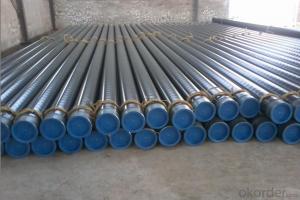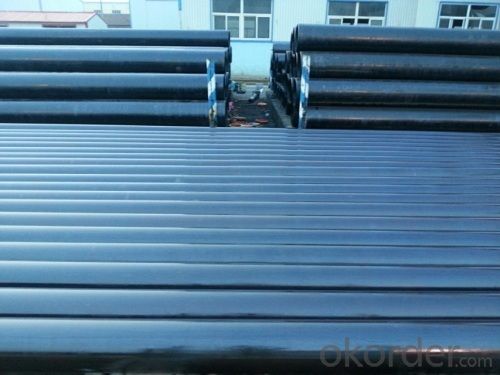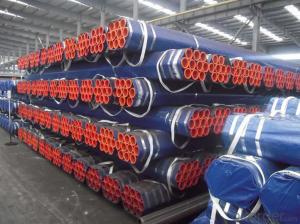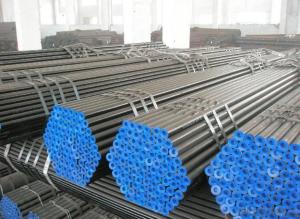Seamless black steel pipe API,GB,ASTM,ASME,DIN
- Loading Port:
- Tianjin
- Payment Terms:
- TT OR LC
- Min Order Qty:
- 10 m.t.
- Supply Capability:
- 5000 m.t./month
OKorder Service Pledge
OKorder Financial Service
You Might Also Like
1. Commodity Name: Seamless steel pipe
2. Standard: API,GB,ASTM,ASME,DIN
3. Quality grade: 10#, 20#, A106B, A53B, API 5L B, Q235, Q345, ST37-2, ST 45, ST52.etc.
4. Dimension:
OD: 1/2"-24"
WT: 2.5-80mm, SCH10~SCH40~XXL
length: 5.8m,6m,8m,9m,12m
5. Technique: Hot Rolled/Cold Rolled/ Cold Drawn
6. application
carbon seamless steel pipes are widely used in gas, water and oil, transpotation;constructions;Bridge,highway,windows of model steel door; building materials;fences;heating facilities Fluid Pipe;conduit pipe,scaffolding pipe.etc.
7. Payment Terms: L/C D/A D/P T/T
8.packing and shipment
Packaged in bundles,as per customers' requirements, it can also bepackagesd as beveled ends, typed marking, black painting, plastic caps protection,woven bags packing
For 20" container the max length is 5.8m; For 40" container the max length is 12m. other options are available based on customer requests. Please discuss when placing orders.
9. Surface: painted with varnish;
10. Plastic caps at ends.
11. Tolerance: OD +1%/-1%
WT +12.5%/-10%
12. Chemical composition:
Models of Steel Pipes | Chemical Component | |||||||
Steel 20 (ASTM A106B) | C | Si | Mn | P | S | Cu | Ni | Cr |
0.17~0.24 | 0.17~0.37 | 0.35~0.65 | 0.035max | 0.035max | 0.25max | 0.25max | 0.25max | |
Steel45 (ASTM 1045) | 0.42~0.50 | 0.17~0.37 | 0.50~0.80 | 0.035max | 0.035max | 0.25max | 0.25max | 0.25max |
16Mn(Q345B) | 0.12~0.20 | 0.20~0.55 | 1.20~1.60 | 0.035max | 0.035max | 0.25max | 0.25max | 0.25max |
45Mn2 ( ASTM1345) | 0.42~0.49 | 0.17~0.37 | 1.40~1.80 | 0.035max | 0.035max | 0.3max | 0.3max | 0.30max |
- Q: How are steel pipes used in the construction of telecommunications towers?
- Steel pipes are used in the construction of telecommunications towers as they provide structural support and stability. They are used as the main framework for the tower, forming the vertical columns, horizontal bracing, and diagonal supports. These pipes are capable of withstanding heavy loads, high winds, and other environmental factors, ensuring the tower's durability and longevity. Additionally, steel pipes allow for easy installation and maintenance of antennas, cables, and other telecommunications equipment.
- Q: What are the different strategies for pipe laying using steel pipes?
- Various strategies exist for laying steel pipes, each tailored to specific environments and needs. Here are a few commonly used approaches: 1. Open Trench: The traditional and widely employed method involves digging a trench along the desired pipeline route. Steel pipes are then placed in the trench, aligned, and welded together. This technique allows for easy access, maintenance, and repair of the pipeline. 2. Direct Pipe: This method is utilized when the pipeline needs to pass beneath obstacles like rivers or highways. It entails drilling a borehole from one side to the other while simultaneously laying the steel pipe. The pipe is subsequently pulled through the borehole, resulting in a continuous pipeline. 3. Horizontal Directional Drilling (HDD): HDD is employed when the pipeline must be installed beneath existing infrastructure or environmentally sensitive areas. A pilot hole is drilled horizontally, and the steel pipe is then pulled through using a reaming tool. This approach minimizes surface disruption and reduces environmental impact. 4. Sliplining: This technique involves inserting a smaller diameter steel pipe into an existing larger pipe. The smaller pipe is pushed or pulled into the larger one, providing a new corrosion-resistant lining. Sliplining is commonly used for rehabilitating deteriorated or damaged pipelines. 5. Microtunneling: Similar to HDD, microtunneling employs a microtunnel boring machine (MTBM) that simultaneously excavates the soil and installs the steel pipe. This method is frequently used for precise pipe laying, particularly in urban areas with limited space. 6. Jacking: Jacking, also referred to as pipe jacking or pipe ramming, is suitable for installing steel pipes in soil conditions that are unsuitable for open trenching. Hydraulic jacks or pneumatic rams are used to push the steel pipe into the ground. Jacking is commonly employed for crossing under railways, roads, or buildings. 7. Offshore Pipeline Laying: When it comes to subsea applications, various techniques can be employed, including S-lay, J-lay, or reel-lay. These methods involve deploying the pipeline from a vessel, either vertically or at an inclined angle, and welding the steel pipes together as they are lowered to the seabed. Each strategy possesses unique advantages and considerations, depending on factors such as terrain, environmental impact, existing infrastructure, and project requirements. It is crucial to thoroughly assess these factors and select the most appropriate pipe laying strategy to ensure the safe and efficient installation of steel pipes.
- Q: How are steel pipes used in the aerospace industry?
- Steel pipes are commonly used in the aerospace industry for various applications such as fuel lines, hydraulic systems, and structural components. These pipes provide strength, durability, and resistance to high pressure and extreme temperatures, making them ideal for delivering fluids and gases, supporting critical systems, and ensuring the structural integrity of aircraft and spacecraft.
- Q: How are steel pipes used in the manufacturing of sewage treatment plants?
- Steel pipes are commonly used in the manufacturing of sewage treatment plants for various purposes such as conveying wastewater, transporting chemicals and gases, and facilitating the distribution of treated water. They provide durability, corrosion resistance, and structural stability necessary for the efficient and reliable operation of sewage treatment processes.
- Q: How are steel pipes used in the oil and gas pipeline transportation?
- Steel pipes are widely used in the oil and gas industry for pipeline transportation due to their durability, strength, and resistance to corrosion. These pipes are specifically designed to withstand high pressure and transport various types of fluids, including crude oil, natural gas, and refined petroleum products. In oil and gas pipeline transportation, steel pipes are primarily used for three main purposes: gathering, transmission, and distribution. Gathering pipelines are responsible for collecting oil and gas from the production wells and transporting them to processing facilities. Steel pipes are used in these pipelines due to their ability to withstand the harsh conditions of the extraction sites and effectively transport the fluids over long distances. Transmission pipelines are used to transport oil and gas over vast distances, sometimes spanning across countries or continents. Steel pipes are ideal for this purpose as they can handle high pressure, ensuring the efficient flow of fluids over long distances. These pipes are often buried underground or submerged in water to protect them from external elements and minimize the risk of damage. Distribution pipelines are responsible for delivering oil and gas to end-users, such as homes, businesses, and industrial facilities. Steel pipes are commonly used in these pipelines as they can handle the varying demand and pressure requirements of different consumers. These pipes are often smaller in diameter compared to transmission pipelines but still provide reliable and safe transportation of oil and gas to their final destinations. In addition to their strength and durability, steel pipes used in oil and gas pipeline transportation are also coated or lined with various materials to enhance their resistance to corrosion and minimize the risk of leaks. These protective coatings and linings ensure the longevity of the pipes and maintain the integrity of the transported fluids. Overall, steel pipes play a crucial role in the oil and gas industry by providing a reliable and efficient means of transporting oil and gas from production sites to processing facilities and ultimately to end-users. Their durability, strength, and resistance to corrosion make them an ideal choice for pipeline transportation in this industry.
- Q: Are steel pipes suitable for potable water applications?
- Yes, steel pipes are suitable for potable water applications. Steel pipes are commonly used for transporting water in various industries and municipal water systems. They are known for their durability, strength, and resistance to corrosion, making them a reliable choice for potable water systems. Steel pipes also have the advantage of being able to withstand high pressure and temperature conditions, making them suitable for both hot and cold water applications. Additionally, steel pipes can be easily welded, ensuring leak-free connections. However, it is important to note that the quality of the steel used and proper maintenance are crucial factors in ensuring the safety and suitability of steel pipes for potable water applications. Regular inspection and maintenance should be done to prevent corrosion and ensure the integrity of the pipes.
- Q: What is the process of coating steel pipes?
- The process of coating steel pipes involves several steps. First, the pipes are cleaned and prepared to remove any dirt, grease, or rust. Then, a primer is applied to the surface of the pipes to enhance adhesion. After the primer dries, a coating material such as epoxy, polyethylene, or zinc is applied using various methods like spraying, dipping, or wrapping. This coating material not only provides protection against corrosion but also acts as a barrier against external elements. Finally, the coated pipes are cured or dried to ensure the coating adheres properly and forms a durable layer, ready for use in various industries such as oil and gas, water supply, or construction.
- Q: Can steel pipes be used for solar energy systems?
- Yes, steel pipes can be used for solar energy systems. Steel pipes are commonly used for the construction of solar water heating systems and solar thermal collectors. They are durable, resistant to corrosion, and can efficiently transport hot water or heat transfer fluids, making them suitable for various solar energy applications.
- Q: How are steel pipes used in the manufacturing of ships?
- Steel pipes are used in the manufacturing of ships for various purposes, including structural support, fluid transportation, and ventilation systems. They are commonly used to create the framework of the ship, providing strength and stability. Additionally, steel pipes are used to transport fluids such as water, oil, and gas throughout the vessel. They are also utilized in the ship's ventilation system to ensure proper air circulation and maintain a safe environment for crew members.
- Q: What is the difference between API 5L and ASTM A106 steel pipes?
- API 5L and ASTM A106 steel pipes are both widely used in the oil and gas industry, but they have some key differences. API 5L is a specification for seamless and welded steel pipes used for pipeline transportation systems in the petroleum and natural gas industries. It covers various grades of carbon and alloy steel pipes, with different strength levels and impact requirements. API 5L pipes are designed for conveying fluids, such as oil, gas, and water, over long distances. On the other hand, ASTM A106 is a specification for seamless carbon steel pipes used for high-temperature service. It covers seamless pipes for pressure and mechanical applications, including transportation of fluids and gases in industries like refineries, power plants, and boilers. While both API 5L and ASTM A106 pipes are used in similar applications, the main difference lies in their intended use and the specific requirements they must meet. API 5L pipes are primarily used for pipeline transportation systems, whereas ASTM A106 pipes are more focused on high-temperature service applications. Additionally, the manufacturing processes and testing requirements for both specifications may vary.
Send your message to us
Seamless black steel pipe API,GB,ASTM,ASME,DIN
- Loading Port:
- Tianjin
- Payment Terms:
- TT OR LC
- Min Order Qty:
- 10 m.t.
- Supply Capability:
- 5000 m.t./month
OKorder Service Pledge
OKorder Financial Service
Similar products
Hot products
Hot Searches
Related keywords


























